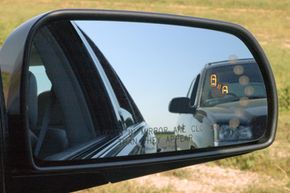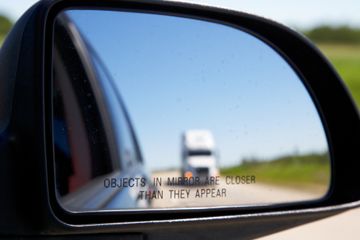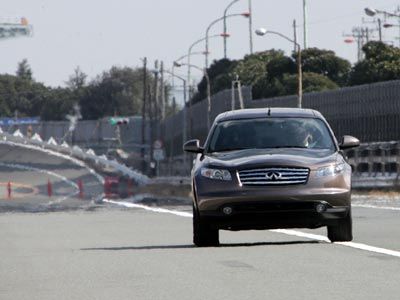Every auto manufacturer approaches the problem of blind-spot detection in a slightly different manner, but we can loosely group the new blind-spot monitoring technologies into two different categories: active and passive.
Active Blind Spot Monitoring: A typical blind spot monitoring system uses some kind of electronic detection device(s) mounted on the sides of the car (often in the vicinity of the external rear view mirrors or near the rear bumpers) that sends out either electronic electromagnetic waves (usually in the radar wavelengths) or takes computer-processed images with a digital camera and analyzes them. When one of these detectors notices another vehicle getting too friendly with your car, it tells you about it, usually by flashing a light in the driver's peripheral vision or by making audible sounds -- often using both methods, depending on how likely it looks that you're going to steer your car into the other car. In the most advanced systems, your car will even try to steer itself back into the safety zone of its previous lane.
Let's examine how different auto manufacturers are handling this safety issue:
- Volvo: Wouldn't you know it? Volvo, a company that feels about driving safety the way that Ferrari feels about auto racing, was the first to introduce an automated blind spot detection system into one of their cars back in 2005. It's called the Blind Spot Information System (BLIS), and it blissfully watches for approaching cars on both left and right that the driver can't see. Initially, it used cameras placed in the car's side rear view mirrors, and a computer processed the image from those cameras to see if anything looked like a car and seemed to be approaching dangerously into the area where you might hit it while changing lanes. Newer Volvo BLIS systems, however, use radar (electromagnetic waves that bounce off solid objects and return an echo indicating if they're there) and are mounted in the rear of the car, in the vicinity of the back bumpers. The presence of a hidden vehicle will cause an LED to glow on the A-pillar, the column at the edge of the windshield just to the left of the driver. If you switch on your turn signal to indicate that you plan to enter that lane, the light will start flashing, letting you know that your car is very nervous about your intended maneuver.
- Ford: Once upon a time, when the current decade was new and "Lost" was still on television, Ford owned Volvo, so it isn't at all surprising that Ford vehicles tend to use the same BLIS system that Volvo developed. Like Volvo, Ford places radar-based detectors near the rear of the car, but the light that flashes to warn you that something invisible is sneaking up on you is on the outside rear view mirror, corresponding to the side that has the unseen intruder.
- Audi: Audi Side Assist, the German manufacturer's answer to BLIS, will detect cars coming up from as far as 150 feet (45.7 meters) behind you in adjoining lanes and flash a light in your external rearview mirror.
- Infiniti: Okay, everyone, get ready for the blind spot detection system of the future. Infiniti, which seems to have the edge on everyone else at this moment, actually has two built-in systems. The first, called simply Blind-Spot Warning (BSW), works pretty much like the other carmaker's systems work. It uses radar to detect vehicles approaching from the side, with blinking LEDs in the rear view mirrors to indicate a car in the blind spot. Use the turn signal to indicate a change into the dangerous lane and a noise-warning starts beeping. But actually try to turn your car into the blocked lane and that's where Infiniti really makes its great leap forwards -- or sideways, depending on how you look at it. The Blind Spot Intervention (BSI) System will start gently applying the brakes on the side of the car away from the danger, causing the vehicle to slowly swerve back toward the safe lane. Presumably you can override this gentle nudge if you push the wheel hard enough, but it wouldn't be a good idea to do so. Momma Infiniti knows best.
Luxury cars are the most likely to have blind-spot detection systems (BMW's vibrates the wheel if you try to make an unsafe lane change) and these active blind spot avoidance systems are not available in all models of car yet, even from those manufacturers that have already introduced them. They're typically an optional item and will set you back at least a few hundred extra bucks, possibly thousands if they come as part of a more extensive safety package. But the good news is that prices are dropping rapidly and within a few years most new cars will have safety systems like this, or at least will offer them as easily affordable options.
Passive Blind Spot Monitoring: Passive blind spot warning systems involve -- surprise! -- a mirror. Talk about low tech! Many car manufacturers will offer you the alternative to put a special convex mirror in the corner of your current external rearview mirror that can see into areas where normal rearview mirrors cannot. And if you don't have one of these on your current car, you can probably walk into your local auto parts store, buy one, and install it yourself (though be warned that experts advise against self installation because the precise positioning of these mirrors is crucial). Amazingly, tests have shown these special mirrors, which are the cheapest form of blind-spot monitoring system imaginable, are every bit as effective as sophisticated (and expensive) radar-based systems. And surveys show that consumers who have used both actually prefer the mirror to the radar -- if only because the mirror doesn't blink annoying warning lights at you or make beeping noises. So it's possible that the best state-of-the-art blind spot monitoring system may be one that's been state-of-the-art since the ancient past.


